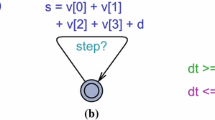Abstract
Purpose
To successfully ablate moving tumors in robotic radio-surgery, it is necessary to compensate for motion of inner organs caused by respiration. This can be achieved by tracking the body surface and correlating the external movement with the tumor position as it is implemented in the CyberKnife\(^\circledR \) Synchrony system. Tracking errors, originating from system immanent time delays, are typically reduced by time series prediction. Many prediction algorithms exploit autoregressive (AR) properties of the signal. Estimating the optimal model order \(p\) for these algorithms constitutes a challenge often solved via grid search or prior knowledge about the signal.
Methods
Aiming at a more efficient approach instead, this study evaluates the Akaike information criterion (AIC), the corrected AIC, and the Bayesian information criterion (BIC) on the first minute of the respiratory signal. Exemplarily, we evaluated the approach for a least mean square (LMS) and a wavelet-based LMS (wLMS) predictor.
Results
Analyzing 12 motion traces, orders estimated by AIC had the highest prediction accuracy for both prediction algorithms. Extending the investigations to 304 real motion traces, the prediction error of wLMS using AIC was found to decrease significantly by 85.1 % of the data compared to the original implementation
Conclusions
The overall results suggest that using AIC to estimate the model order \(p\) for prediction algorithms based on AR properties is a valid method which avoids intensive grid search and leads to high prediction accuracy.



Similar content being viewed by others
References
Giraud P, De Rycke Y, Dubray B, Helfre S, Voican D, Guo L, Rosenwald JC, Keraudy K, Housset M, Touboul E, Cosset JM (2001) Conformal radiotherapy (CRT) planning for lung cancer: analysis of intrathoracic organ motion during extreme phases of breathing. Int J Radiat Oncol 51(4):1081–1092
McQuaid D, Webb S (2006) IMRT delivery to a moving target by dynamic MLC tracking: delivery for targets moving in two dimensions in the beam’s eye view. Phys Med Biol 51(19):4819–4839
Buzurovic I, Huang K, Yu Y, Podder TK (2011) A robotic approach to 4D real-time tumor tracking for radiotherapy. Phys Med Biol 56(5):1299–1318
Wilbert J, Meyer J, Baier K, Guckenberger M, Herrmann C, Hess R, Janka C, Ma L, Mersebach T, Richter A, Roth M, Schilling K, Flentje M (2008) Tumor tracking and motion compensation with an adaptive tumor tracking system (ATTS): system description and prototype testing. Med Phys 35(9):3911–3921
Ahn S, Yi B, Suh Y, Kim J, Lee S, Shin S, Shin S, Choi E (2004) A feasibility study on the prediction of tumour location in the lung from skin motion. Br J Radiol 77(919):588–596
Schweikard A, Glosser G, Bodduluri M, Murphy MJ, Adler JR (2000) Robotic motion compensation for respiratory movement during radiosurgery. Comput Aided Surg 5:263–277
Krauss A, Nill S, Oelfke U (2011) The comparative performance of four respiratory motion predictors for real-time tumour tracking. Phys Med Biol 56(16):5303–5317
Ernst F (2011) Compensating for quasi-periodic Motion in robotic radiosurgery. Springer, USA
Ernst F, Schlaefer A, Schweikard A (2011) Predicting the outcome of respiratory motion prediction. Med Phys 38(10):5569–5581
Ernst F, Schlaefer A, Schweikard A (2007) Prediction of respiratory motion with wavelet-based multiscale autoregression. In: Medical image computing and computer-assisted intervention MICCAI 2007, vol 4792. Springer, Berlin, HD, pp 668–675
Burg J (1975) Maximum entropy spectral analysis. PhD thesis, Stanford University
Hastie T, Tibshirani R, Frieman J (2011) The elements of statistical learning: data mining, inference, and prediction. Springer, Berlin
Cavanaugh JE (1997) Unifying the derivations for the akaike and corrected akaike information criteria. Stat Probab Lett 33(2):201–208
Author information
Authors and Affiliations
Corresponding author
Rights and permissions
About this article
Cite this article
Dürichen, R., Wissel, T. & Schweikard, A. Optimized order estimation for autoregressive models to predict respiratory motion. Int J CARS 8, 1037–1042 (2013). https://doi.org/10.1007/s11548-013-0900-0
Received:
Accepted:
Published:
Issue Date:
DOI: https://doi.org/10.1007/s11548-013-0900-0




